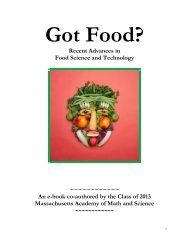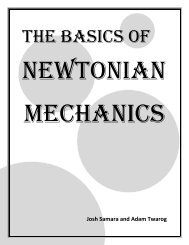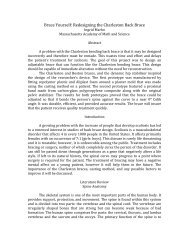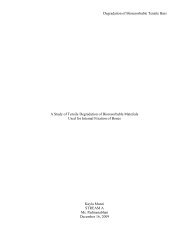In the Light of Occam's Razor: A Critical Analysis of Parapsychology
In the Light of Occam's Razor: A Critical Analysis of Parapsychology
In the Light of Occam's Razor: A Critical Analysis of Parapsychology
You also want an ePaper? Increase the reach of your titles
YUMPU automatically turns print PDFs into web optimized ePapers that Google loves.
activity fall to mere supposition when viewed through <strong>the</strong> lens <strong>of</strong> Occam’s razor. The largest <strong>of</strong><br />
<strong>the</strong>se assumptions was that made by J. B. Rhine in his study <strong>of</strong> extrasensory perception (ESP).<br />
To examine <strong>the</strong> existence <strong>of</strong> what he believed to be psi phenomena, Rhine conducted tests in<br />
which subjects attempted to guess <strong>the</strong> order <strong>of</strong> cards in a set on which was inscribed one <strong>of</strong> five<br />
symbols. Over 90,000 <strong>of</strong> <strong>the</strong>se tests were completed, and from <strong>the</strong> ga<strong>the</strong>red data, this<br />
investigator asserted that ESP is a real and quantifiable happening (Rhine, 1973). This<br />
conclusion was based upon a small number <strong>of</strong> test subjects who were able to guess a larger<br />
percentage <strong>of</strong> <strong>the</strong> cards correctly than statistical chance predicted. Such data does not tend to<br />
show <strong>the</strong> absolute truth <strong>of</strong> <strong>the</strong> hypo<strong>the</strong>sized occurrence, as it is not a preponderance <strong>of</strong> <strong>the</strong><br />
evidence and makes unjustifiable leaps to outlandish explanations. Adhering to <strong>the</strong> law <strong>of</strong><br />
parsimony, <strong>the</strong>re are various potential explanations for <strong>the</strong>se statistical anomalies with <strong>the</strong> first<br />
being simple chance. With such a large number <strong>of</strong> tests performed, it is likely that some data<br />
points will lie outside <strong>of</strong> <strong>the</strong> predicted average. Fur<strong>the</strong>rmore, dishonesty in experimental<br />
procedure could very likely account for <strong>the</strong>se outliers in <strong>the</strong> data. Greater than ten individuals<br />
who assisted Rhine were found to be involved in fraudulent activities, yet <strong>the</strong>ir names were never<br />
released and data ga<strong>the</strong>red with <strong>the</strong>ir involvement was used to arrive at <strong>the</strong> final, bold statement.<br />
Such simple interpretations <strong>of</strong> <strong>the</strong> data place <strong>the</strong> idea <strong>of</strong> metaphysical happenings far beyond <strong>the</strong><br />
scope <strong>of</strong> veritable science.<br />
A second tenet in <strong>the</strong> field <strong>of</strong> parapsychology is <strong>the</strong> belief in <strong>the</strong> supernatural importance<br />
<strong>of</strong> near-death experiences. By definition, a so-called near-death experience occurs when an<br />
individual comes close to death or experiences clinical death and is revived; many <strong>of</strong> those who<br />
have been in such a state report feeling elation and seeing <strong>the</strong> image <strong>of</strong> a light forming at <strong>the</strong> end<br />
<strong>of</strong> a tunnel (“Near-Death Experiences”, n.d.). Men and women <strong>of</strong> <strong>the</strong> pseudoscientific world<br />
have attributed <strong>the</strong>se feelings to a variety <strong>of</strong> phenomena including <strong>the</strong> journey to a realm <strong>of</strong> life<br />
after death and have <strong>of</strong>fered <strong>the</strong>se qualitative observations as evidence <strong>of</strong> <strong>the</strong> pr<strong>of</strong>essed afterlife.<br />
These individuals have strived to make scientific claims based solely upon <strong>the</strong> vague accounts <strong>of</strong><br />
those who underwent such trauma, and thus base what <strong>the</strong>y believe to be rational conclusions<br />
upon questionable, second-hand observations.<br />
<strong>In</strong> addition to this fundamental error in <strong>the</strong> scientific reasoning behind parapsychologists’<br />
explanation for <strong>the</strong>se visions, <strong>the</strong> religious and paranormal associations <strong>of</strong> near-death<br />
experiences are inane when viewed in <strong>the</strong> light <strong>of</strong> Occam’s razor. A plethora <strong>of</strong> simple,<br />
scientifically accepted causes for <strong>the</strong>se commonly reported sensations exist. The first <strong>of</strong> <strong>the</strong>se<br />
elucidations is that humans close to death <strong>of</strong>ten enter a state <strong>of</strong> shock, in which <strong>the</strong>y may<br />
experience delirium and impaired sensory perception, hence <strong>the</strong> sight <strong>of</strong> a small amount <strong>of</strong> light<br />
and feeling <strong>of</strong> euphoria. Ano<strong>the</strong>r logical cause <strong>of</strong> contentment and unusual visions during a<br />
near-death experience are <strong>the</strong> potential physical ailments that caused a person to enter an infirm<br />
state. Two common conditions that cause death or near-death are brain trauma and severe blood<br />
loss, both <strong>of</strong> which can cause impaired mental abilities and altered visual perspective. These<br />
explanations for <strong>the</strong> sensations <strong>of</strong> near-death experiences are significantly more parsimonious to<br />
<strong>the</strong> conventions <strong>of</strong> science, and thus must be considered before <strong>the</strong> miraculous contrivances <strong>of</strong><br />
parapsychologists.
















